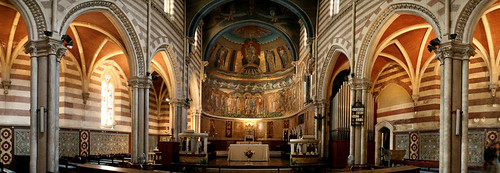I came across this little known church one morning. I can not find it listed in any of the guide books, but there may be a reason for that. The church is the first non-Roman Catholic church to be built in Rome. What captured me most about it was the relative simplicity of designed and decoration compared to many other Roman churches. Overall the building has a lighter feel than most, and the colours of the tiles and brickwork are much more plain. That said there are some lovely mosaics and tile work designed by Edward Burne-Jones.
Here is the history of how the first non-Catholic church in Rome came to be:
For many centauries the Popes ruled, not only the Catholic Church, but also large areas of lands as well, called Papal States. During the reign of Pius IX, the temporal forces in Italy, led by King Victor Emmanuel II in 1861, declared war on the Papacy and began to conquer the Papal States. The last to fall was Rome in 1870, mostly because of French forces garrisoned there by Napoleon III for the Pope’s protection. When these forces were withdrawn to defend France, the Italians sent an ambassador to the Pope offering a solution. This was rejected along with the declaration from the Pope that the Italian forces “you will never enter Rome!”
10 days later the last Papal State, Rome, fell into civil hands.
Under the new civil rule it was now possible for non-Catholic churches to be built in Rome, and so the new church began in 1873 with a brick from Independence Hall, as a symbol of religious liberty in the city. It was designed by George Edmund Street.
It took almost 100 years for the Catholic church to be reconciled to the existence of this Anglican church. Thus, on December 1960, the church was visited by Blessed Pope John XXIII together with the Anglican Archbishop of Canterbury, Geoffrey Fischer. This is commemorated with an inscription by the door. St. Paul-within-the-Walls continues as an Anglican community today, details about them can be found on their church website.
The panoramic image of this location as shown on the
For more articles on Rome see the Rome Index or select one of the labels at the bottom.

No comments:
Post a Comment